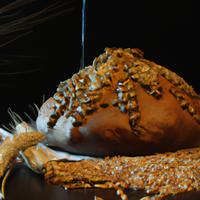
1 serving (100 grams) contains 300 calories, 6.0 grams of protein, 15.0 grams of fat, and 40.0 grams of carbohydrates.

Log this food in SnapCalorie

Nutrition Information
Calories |
714.3 | ||
|---|---|---|---|
% Daily Value* |
|||
| Total Fat | 35.7 g | 45% | |
| Saturated Fat | 11.9 g | 59% | |
| Polyunsaturated Fat | 0 g | ||
| Cholesterol | 23.8 mg | 7% | |
| Sodium | 476.2 mg | 20% | |
| Total Carbohydrates | 95.2 g | 34% | |
| Dietary Fiber | 11.9 g | 42% | |
| Sugars | 23.8 g | ||
| protein | 14.3 g | 28% | |
| Vitamin D | 0 mcg | 0% | |
| Calcium | 47.6 mg | 3% | |
| Iron | 4.8 mg | 26% | |
| Potassium | 357.1 mg | 7% | |
* Percent Daily Values are based on a 2,000 calorie diet. Your daily values may be higher or lower depending on your calorie needs.
Food Attributes
Source of Calories
About Whole grain pastry
Whole grain pastry combines the richness of traditional baked goods with the nutritional benefits of whole grains. Made using whole wheat flour or other whole grain options, it retains the bran, germ, and endosperm of the grain, offering higher fiber, vitamins, and minerals compared to refined flour pastries. Commonly found in Western and European cuisines, it can be used in desserts like tarts or savory dishes like hand pies. While whole grain pastry provides more sustained energy and supports digestive health due to its fiber content, it may still contain added sugars, butter, or oils depending on the recipe, which can increase calorie and fat content. Opting for versions with less sugar and healthier fats can enhance its nutritional profile. This versatile treat is a balanced way to enjoy baked goods without sacrificing wholesome ingredients.



